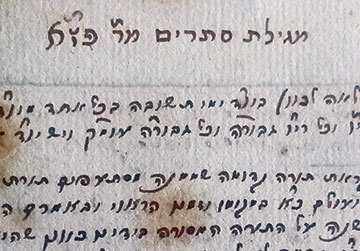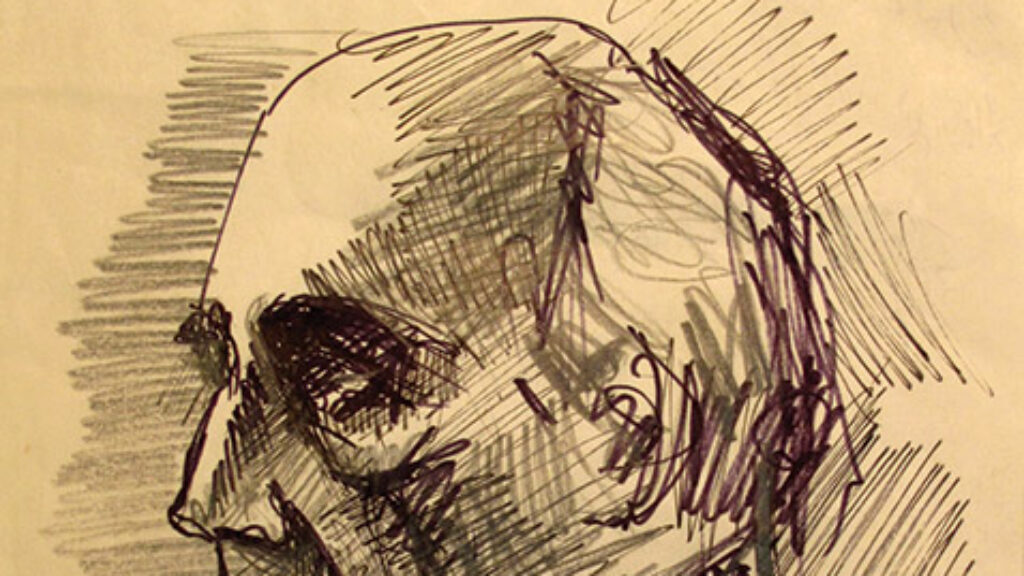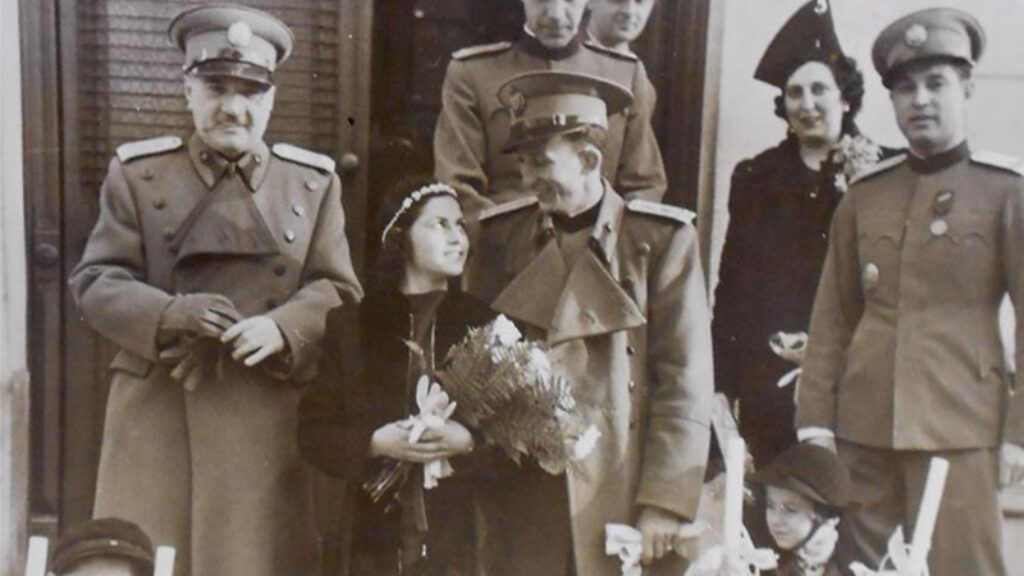The Angel and the Covenant
Sometime in the 1770s, Rabbi Shmelke of Nikolsburg, one of the closest disciples of the Maggid of Mezheritch, decided to bring the new teachings of Hasidism to his brethren in Western Europe. As the story goes, he was halted at the German border by the Angel of Death, who told him, “This is not your place.” Shmelke hesitated, but went on. The angel warned him again, but Shmelke stuck to his course. “If you spread your teachings in this land,” the angel warned him, “I will personally make sure that all the Jews here become Hasidim.” At this, Shmelke stopped, realizing that it would radically alter the nature of the movement, thus Hasidism remained an Eastern European Jewish phenomenon.
Although Sefer ha-Brit (Book of the Covenant) by Pinchas Eliyahu Hurwitz (1765–1821) was an attempt to bring the news of 18th-century science, not Hasidism, to its Jewish readers, it too was an essentially Eastern European Jewish phenomenon. Throughout the 19th century, it was the main source of scientific information and natural history for traditional Eastern European Jews, though of course much of it was fanciful or already outdated (for instance the medieval notion that there are geese in Scotland that grow botanically, like barnacles, on trees).
The book was first published anonymously in 1797 in Brünn, Moravia (modern-day Brno, Czech Republic) and quickly became a best-seller, occasioning speculation that the author was really Rabbi Eliyahu of Vilna, the great Vilna Gaon, or, perhaps, the late philosopher Moses Mendelssohn. Following a pirated 1800–1801 edition, Hurwitz published an expanded edition with his name in Zolkiew in 1806–1807. In that preface, he boasts that copies of the book were even sold in Holland, England, France, and Italy. Yet, of the 40 editions that are meticulously documented in an appendix to the distinguished historian David B. Ruderman’s fascinating new study of Sefer ha-Brit, not one was printed in Western Europe. Neither of the two parts of the book—the first part consisting of a concise, popular compendium of modern science, nor the second part comprising a treatise on kabbalistic piety—apparently had much to offer Western Jews. The 41st edition just appeared in Israel, where it still finds a receptive haredi audience, interested primarily in the book’s kabbalistic and ethical teachings.

According to one account, Pinchas Eliyahu Hurwitz was born to Meir and Yente Hurwitz in Lvov, while they were traveling from their hometown of Vilna to Buczacz, Galicia. Yitzhak Lax, the editor of the recent haredi edition of Sefer ha-Brit, speculates that the couple left Vilna because of its anti-Hasidic edicts. But Lax provides no historical evidence for his claim, and the major campaign against the Hasidim did not begin until 1772, when Pinchas Eliyahu was seven years old or so.
Hurwitz’s father died while he was still a child, and apparently he began wandering not long afterward. In spite of the great interest on the part of both academic and religious scholars in Hurwitz, very little is known about his biography beyond the fact that he was married and had children. According to his own testimony, he began writing Sefer ha-Brit while residing in Buczacz sometime in the mid-1780s. In the following dozen years, Hurwitz would travel as far as Berlin, Pressburg, Amsterdam, the Hague, and London. During these travels he continued working on the book intermittently, acquiring the approbation of several notable rabbinic figures, until eventually he published the book in Brünn.
Hurwitz composed several other works, most of them kabbalistic commentaries, though none of them were published in his lifetime. “Why should a kabbalist bother to master natural philosophy when his ultimate goal was to transcend his earthly existence and enter a spiritual place beyond nature itself?” Ruderman asks pointedly. His answer is that, for Hurwitz, the study of nature “revealed constantly the majesty of the creator and the finitude of his created beings.” But, arguably, there were other motivations at work as well.
Hurwitz perceived himself as a kanai (zealot) whose aim was to defend the honor of rabbinic culture. Thus, in Sefer ha-Brit, he launches a fascinating attack on the study of philosophy (mainly, metaphysics), which he associates with heresy. At the same time, he admits to a sense of shame at the Gentiles’ alleged perception of the Jews as “a nation lacking intelligence except in the Talmud.” Hurwitz’s ideal Jew is the rabbinic scholar who is also knowledgeable about, and open to, modern science, and yet he was very far from Moses Mendelssohn or any other Haskalah figure. He was, rather, what could be called an exponent of the Jewish counter-enlightenment. That is to say that he adopted (and occasionally even radicalizes) some elements from the Haskalah’s world view while essentially defending traditional talmudism.
Somewhat like Hasdai Crescas, the late 14th-century thinker, Hurwitz attempted to use the tools of philosophy in order to undermine what he perceived as the tyranny of rationalism. Crescas had skillfully attacked the tenets of Aristotelian physics in order to undermine Maimonidean rationalism at its foundations. Hurwitz did not have the talent of a Crescas, who may have been a more original and acute philosopher than Maimonides, but he also didn’t need it, since he had Immanuel Kant. Kant’s Critique of Pure Reason had recently seemed to clear away a space for traditional faith by undermining the overweening claims of reason, thus justifying what Ruderman describes as Hurwitz’s “unwavering fideism.” He draws upon Kant’s attack on the pretenses of reason extensively, and then goes on to rebut Salomon Maimon’s attempt to defend rationalism from Kant (though, in truth, he might have actually learned of Kant’s arguments from reading Maimon).
Ruderman’s study of Sefer ha-Brit is an excellent entry into the recent subgenre of microhistories of odd or influential books, and, for the most part, his discussion of Hurwitz’s views is nuanced and precise. One exception, it seems to me, is his discussion of Hurwitz’s exploration of the religious duty to love all human beings. Hurwitz devoted one of the longest chapters of Sefer ha-Brit to this obligation, which, among other things, he regarded as a precondition for the ascent to prophecy.
Ruderman seems to be at a loss to understand Hurwitz’s repeated insistence that the biblical command to love one’s neighbor had as its object all human beings, not merely other Jews. He admits that previous rabbinic figures preached tolerance and fairness toward Gentiles, yet, he claims, “there were limits to these positions, since the emphasis was always on correct behavior and tolerance, not on love . . . Even the enlightened Moses Mendelssohn spoke about toleration, not love.” Ruderman ends up speculating on the possible influence of Freemasonry on Hurwitz:
Whether or not Hurwitz or his readers fully grasped the import of his message, it appears in hindsight that he had indeed articulated a radical understanding of Judaism for his time and perhaps for ours as well.
While I share much of Ruderman’s admiration of Hurwitz, I believe this is overstated. To be sure, Ruderman cites chauvinistic and xenophobic views in a variety of Jewish literary genres throughout the centuries, and I think this recognition is both morally important and, regrettably, factually correct. Yet he fails to account for the persistence of a universalist—sometimes even egalitarian—attitude toward Gentiles at the very core of rabbinic culture.
The command to love one’s Gentile neighbor was hardly Hurwitz’s invention. Consider Leviticus 19:34—“The stranger [ger] who resides with you shall be to you as one of your citizens; you shall love him [ve-ahavta lo] as yourself”—or Deuteronomy 10:19—“You shall love the stranger [ve-ahavtem et ha-ger], for you were strangers in the land of Egypt.” Rabbinic commentators on these two verses (as well as the 34 other verses referring to the ger) disagree on whether the word “ger” refers to an alien resident (ger toshav) or to a convert (ger tzedek). The major medieval commentator, Abraham ibn Ezra, systematically interprets the word as referring to a Gentile foreigner. His is not the majority view, but it is not a radical outlier in the tradition either. A cursory examination of traditional interpretations of the mishnaic notion of “ahavat ha-briot” (love of human creatures) will yield numerous sources—medieval and early modern—that apply it to all of humanity. Perhaps the best proof that Hurwitz’s preaching of universal love of humanity was not quite as radical as Ruderman suggests is the simple fact that, unlike other claims that Hurwitz makes, there is very little evidence that it provoked any critical reaction from traditionalists, despite its status as a best-seller in their world. Indeed, it may well be that this very section contributed to the popularity of the book in traditional circles.
Hurwitz’s biblical namesakes, Pinchas and Eliyahu, are the tradition’s paradigmatic religious zealots. Indeed, in rabbinic and kabbalistic literature, they are merged, so that Eliyahu is presented as having been the reincarnation of Pinchas. Hurwitz played on this tradition when he signed himself with the rabbinic formula “Pinchas zeh Eliyahu” (Phineas, i.e., Elijah) and described himself as a zealot for the honor of the Torah, but he also describes his given name as delegating to him the role of harbinger of peace and human brotherhood. And indeed, in one of the ironic twists of the Bible, Eliyahu the zealous prophet becomes, in Malachi 3:24, the herald of universal peace at the end of days. This twist is extensively interpreted and developed in rabbinic literature, where Elijah becomes an angel of peace and salvation. Thus, Eliyahu, “the angel of the covenant” (malakh ha-brit) is also assigned to welcome the (male) newborn with the “covenant of peace” (brit shalom) at circumcision. Hurwitz did not, of course, choose his name, but, as a close reading of Sefer ha-Brit reveals, he chose to pursue the destiny it encapsulated.
Suggested Reading

On Chaim Grade’s Agunah
Chaim Grade’s Yiddish novel The Agunah is not so much a story about one woman’s plight as much as a whole city’s eruption over her story—the rabbis, the butchers, the mohels, the barbers, the housewives.

Inerrant or Oblique?
John Barton has written a wonderful book about the Bible for believers and nonbelievers alike.

Intrigues and Tzuris
Have you seen the one about the Hasidic jewelers and the Albanian goons?

The Story They’ve Been Telling Themselves
“I wouldn’t turn on my beloved, my sacred husband,” Eva Panić firmly declared. Instead, she chose a brutal Yugoslavian prison–and abandoned her six-year-old daughter. David Grossman transforms their story into a disturbing yet beautiful novel.
Comments
You must log in to comment Log In